The STEM software is a financial evaluation and presentational tool for
networks which offers many benefits for strategy, marketing and financial planners.
The tool provides a robust and efficient platform for creating business and investment
plans which embrace alternative market, technical and economic futures.
This system overview includes a summary of typical data requirements.
STEM integrates communication with calculation
STEM represents a consistent language and flexible framework for evaluating investments
in telecoms businesses:
- Service elements capture demand and tariff assumptions which drive revenues
- Resource elements represent unit costs and build constraints for various assets,
such as hardware, software, licences, buildings and human resources.
Designed as a high-level communication tool, the STEM Model Editor uses icons to
represent these key business plan drivers.
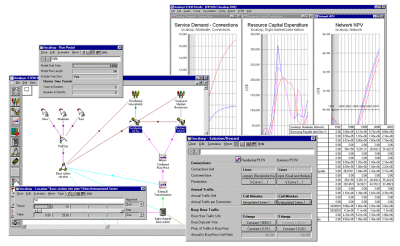
STEM has an intuitive graphical interface
The STEM Model Editor
STEM’s graphical interface is optimised towards the rapid development of business
cases, built either from a standard toolbar of business model elements, such as
services or resources, or by drag-and-drop from existing models. The STEM Model
Editor is an immediate and intuitive presentational device.
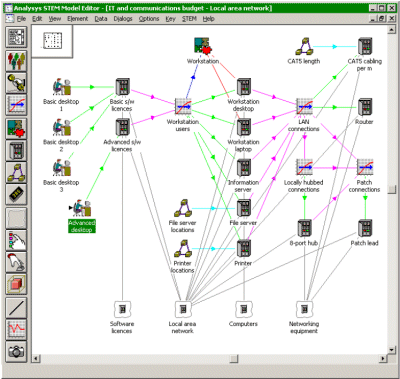
Business case models can be created from a standard toolbar or by drag-and-drop from existing models
Interface with Microsoft Excel
STEM provides an add-in toolbar to aid integration of input data and results:
- STEM inputs may be linked from Excel, including a mechanism which allows all the
assumptions for a given element to be linked from a single named range in Excel
- STEM results are accessed through a worksheet formula implemented by the add-in.
The add-in includes buttons to run models and scenarios from the toolbar, and enables
a STEM user to make an effective synthesis of the familiar interface of Excel with
the dynamic and structural benefits of STEM.
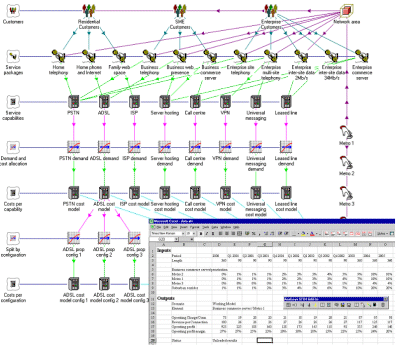
The STEM add-in interface for Excel keeps the inputs and outputs readily accessible,
while retaining the integrity of the model structure in STEM
Results and financial outputs
Based on the structure developed in the Model Editor, STEM automatically generates
a demand and cost-allocation framework, time-series formulae, geographical variants
and scenarios. Input assumptions, which may be linked from Excel or a database,
are expanded by month, quarter or year. Service revenues, equipment installation
and replacement, capex and opex are then calculated. STEM includes parameters for
working capital, tax and interest, gearing, borrowing, equity and dividends, and
also provides full P&L, C/F and balance sheet outputs.
Hundreds of built-in results are delivered through an integrated charting interface
which can drill down into individual elements, revenues and costs:
- service demand in connections, annual traffic, busy-hour traffic or data rate
- service tariffs (connection, rental and usage) and revenues
- resource used, installed and slack capacity
- resource installed and incremental units
- resource capex, depreciation and opex
- network operating profit and profit margin
- allocated service costs, service operating profit and profit margin
- network pre-tax and retained profit
- network return on fixed assets (and may other standard indicators)
- network net present value (NPV) and terminal value (various methods)
- network internal rate of return (IRR).
In addition, the output set is extensible, with user-defined results which can support
an operator’s preferred financial definitions. Thus STEM acts as a time-based revenue,
capex and opex calculator which supports network roll out and investment decisions.
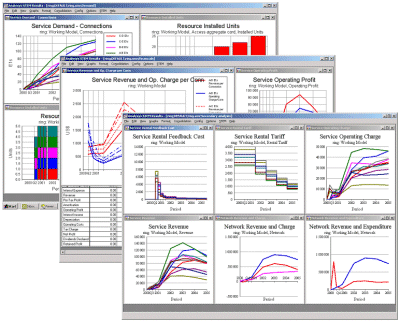
Multiple views in the STEM Results Progam
Topics for STEM modelling
STEM is the natural platform for a wide range of telecoms business case analyses:
- whole-network service costing
- economic evaluation of tentative service products
- comparison of alternative technologies or roll-out strategies
- product analysis and breakdown of costs.
STEM models service demand and equipment installation, categorised by user, service
and geotype. Decision-making is based on quantitative results and sensitivity analysis
using STEM’s integrated multi-dimensional scenario engine.
Typical specific modelling objectives might be to:
- quantify the new revenue opportunity offered by a new technology compared to cannibalised
voice revenues
- benchmark tariffs against the costs of access, transmission, switching and server
equipment
- provide a framework for exploring alternative scenarios for demand, tariffs and
supplier prices.
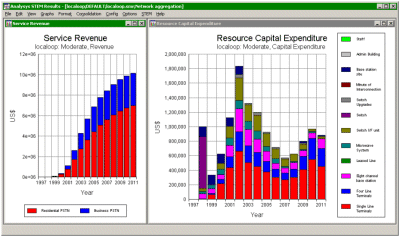
Selection of results from a STEM model
STEM is designed to be technology neutral and has been applied to technologies including
TDM, GSM, UMTS, CDMA, DSL, VoIP, WLAN and satellite. By design, STEM will deliver
a consistent lifetime costing of all assets in order to explore the implications
of business plans for the total cost of ownership, backed up by a clear architectural
and financial model.
STEM methodology and features
The specifics of how STEM works are summarised below. Two volumes of detailed system
documentation are supplied with the software (both in hard copy and as PDF).
- STEM User Guide (400 pages)
- STEM Model Features (320 pages).
Demand-driven model
Assumptions for market segmentation, customers, connections, bandwidth, and annual
and busy-hour traffic drive the calculation of:
- connection, rental and usage revenues
- equipment installation, utilisation and replacement
- capital expenditure, depreciation and operating costs.
Automatic aggregations for profitability and cashflow guarantee integrity of the
results.
Typical data requirements
The elements of STEM may be calibrated with very precise and detailed inputs. However,
the tool is designed to also generate credible business cases for new services with
the minimum of effort, and this section describes the key data required to populate
a model.
Services:
- market segmentation and size
- penetration
- annual traffic volume and busy-hour proportion for voice services
- peak bandwidth and contention ratio for data services
- grade of service
- proportion of subscriber churn
- connection, rental and usage tariffs.
Resources:
- unit capacity, maximum utilisation ratio and physical lifetime
- unit capital cost and other operating costs
- cost trends (both with time and with specific age of equipment)
- financial lifetime and depreciation rate.
Most STEM inputs can be entered as a time series, either with explicit values which
may be linked from Excel, or using one of a range of built-in parameters, including
exponential growth and S-curve.
Additional algorithms aid the rapid development of rich and realistic models
- Erlang B, customer churn, elasticity of demand and cost-dependent tariffs
- pre-run installation, deployment, planned units, technology shift and decommissioning
- cost trends and age factors, economies of scale, overheads and value-chain analysis
- financial parameters for working capital, tax and interest, gearing, borrowing,
equity and dividends
- flexible framework can be extended with user-definable formulae and transformations.
STEM is widely deployed, well tested, interoperable and reliable
- object-oriented editing interface associates data directly with icons and links
between elements
- multiple views provide alternative insights into the model structure
- seamless integration of annual, quarterly and monthly data
- integrated multi-dimensional scenario engine
- end-to-end auditable
- interfaces with Excel and ODBC databases
- comprehensive documentation and online help.
Delivery
We offer three modes of delivery for a STEM model:
|
Conventional STEM
|
(C-STEM) The software is licensed to run on a specific number of desktops, and authorised
with a security key (dongle). The user has full flexibility to create and run models
of arbitrary structure.
|
|
Distributable STEM
|
(D-STEM) In addition to the conventional rights, the user has the facility to create
so-called ‘run-time models’. A run-time model has a fixed structure and may be distributed
to run on keyless machines with varying input assumptions, allowing other teams
to run their own sensitivities through a business model, while expert modellers
retain control over model structure.
|
|
STEM via the Web
|
(eSTEM) A logical extension of the distribution model is to publish models on the
Web. A link in an email can click directly to a customised presentation of key input
parameters and any combination of dynamically updated results in a single screen,
with no need for end users to install or learn new software. This can be exploited
both as an internal distribution mechanism (intranet), as well as a potential platform
for Web-based marketing via the Internet.
|
Technical requirements
The STEM product has been licensed to operators and vendors around the
world for over ten years. STEM runs with minimal footprint on all versions of Windows
(95, 98, ME, NT 4.0, 2000 and XP) and is designed to work seamlessly across these
platforms.
Resourcing and training
A typical STEM user would be well trained with the modelling software and would
have the necessary skills to create flexible and re-useable models from a background
in mathematics, telecoms engineering or financial analysis. Their responsibilities
would typically include working closely with representatives of marketing, technical
planning and finance departments in order to develop highly integrated and credible
business cases.
We have over ten years’ experience training clients around the world, including
incumbent and competitive operators and equipment vendors. The involvement of both
management and intended modellers in a detailed training programme is key to a successful
implementation of STEM. We have a two-phase approach, consisting of two days’ basic
training, followed by a more in-depth workshop, usually a week or two after the
basic training, allowing time for consolidation.
Developing a working understanding of the tool
We have a well-structured basic training course which uses a series of presentations
and an exercise book to lead the novice user through both the basic STEM methodology
and the most important software techniques. This course is deliberately written
around a fictional modelling scenario in order to focus on the concepts. In contrast,
the subsequent workshop focuses on specific modelling issues of current interest
to the client. The basic course covers:
|
Creating market segments
|
Defining a currency unit
|
|
Creating services
|
Defining service tariffs
|
|
Creating resources
|
Defining resource unit costs
|
|
Comparing time series types
|
Creating cost indices and cost trends
|
|
Defining requirements for resources
|
Understanding calibration periods
|
|
Understanding when to use functions
|
Defining global and per-element cost trends, plus age factors
|
|
Reviewing installed units and installed capacity results
|
Creating collections
|
|
Auditing results
|
Accessing online help
|
Illustrative programme for basic training (Day one)
|
Drag-and-drop editing and the link menu
|
Defining user data and user-defined formulae
|
|
Using copy and paste
|
Understanding transformation inputs and basis
|
|
Managing detail with multiple views for icons and results
|
Using expression transformations and cost allocation
|
|
Creating and running scenarios
|
Working with template replication
|
|
Creating locations and selecting a distribution for deployment
|
Creating custom interfaces with the STEM add-in for Excel
|
|
Using a churn proportion for equipment
|
Linking interpolated series data and element defaults
|
|
Removing redundant units
|
Understanding working capital and other financial data
|
|
Combining years, quarters and months
|
Creating new graph definitions
|
Illustrative programme for basic training (Day two)
Consolidating these new skills in application to a pressing issue
The format of the in-depth workshop is much more flexible, but usually involves
a series of intensive ‘whiteboard’ sessions where a problem is first analysed and
characterised, and then translated into an equivalent STEM model. The trainer’s
role is to coach the trainees through all steps of this iterative process. A framework
of objectives is usually agreed at the start of the workshop, and the training concludes
with a summary presentation of the model elements developed during the workshop.
We strongly encourage the maximum attendance for the basic training, in order to
increase the dissemination of skills and thus the value delivered, and also for
the right teams of people to be in place to participate in the workshop. The workshops
we have run in the past have been successful precisely because we involved network
engineers, financial analysts and service product managers. The STEM framework provides
a common language for constructive discussion of all network investment modelling
issues.